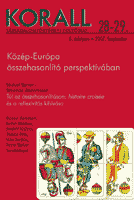Német és magyar agráriusok, 1849–1909
German and Hungarian agrarians 1849–1909
Author(s): András VáriSubject(s): History
Published by: KORALL Társadalomtörténeti Egyesület
Summary/Abstract: The paper attempts to give a parallel review of the “agrarian” movement in Hungary and in Germany. A twofold defi nition is applied for the “agrarian” movement: on the first level, “agrarian” is used to indicate organized advocacy of agricultural interests. On the second level, “agrarian” is used to refer to a popular movement of the rural society protesting against the capitalist mobilization of landed property and its deepening dependence on the world market. Here the development of agrarian movement is analysed through three stages. The first stage extends from the end of the 1870’s until the grain crises of the Central European agriculture. At this stage, diff erent agricultural associations can be identifi ed, which work for agricultural improvement and the spreading of new agricultural techniques and practices. Already at this stage, in the German lands a deeper involvement of rural elites in these associations may be observed than in Hungary. The second stage runs from the onset of the grain crises to the mid-nineties. This stage witnessed a shift towards protective tariff s in Germany, but not in Hungary. The situation of the two economies diff ered substantially, and called forth diff erent responses. But the diff ering situations were only partially responsible for the diff erent reactions. The mobilization to defend the agricultural interests was regionally and socially much more variegated in Germany than in Hungary. At the end of the period, there were attempts in both countries to mass mobilization on a much larger scale than previously. The ideological content of these drives transcended the level of advocacy. The drive resulted in a massorganization in Germany, the Bund der Landwirte, but no equivalent emerged in Hungary, apart from the old style associations. The German movement was much more aggressive, ebullient than its Hungarian counterpart. An explanation to these diff erences is sought by looking at the third period as well. Part of the answer can be found in the particular circumstances at the time of the mobilization drives in the mid-nineties, such as the launching of a popular Catholic party in Hungary, which must have taken up much of the potential followers of a prospective agrarian party. But there are other reasons as well. If we look at the actual activities of the Bund der Landwirte in Germany, we see an enormous range and volume of services, aid, tuition and mediation in farmers’ aff aires. This was largely missing in the corresponding Hungarian association, although the need for these services was felt and discussed. The success of the German Bund der Landwirte as a support organization might have been a key to its success as a political force. A second diff erence is that the great Hungarian landowners might have been unsure of the durability of the Austro-Hungarian Monarchy and therefore reluctant to kick off political mass mobilization. Thirdly and most importantly, the German rural elites might have prov
Journal: Korall - Társadalomtörténeti folyóirat
- Issue Year: 2007
- Issue No: 28-29
- Page Range: 88-108
- Page Count: 21
- Language: Hungarian

